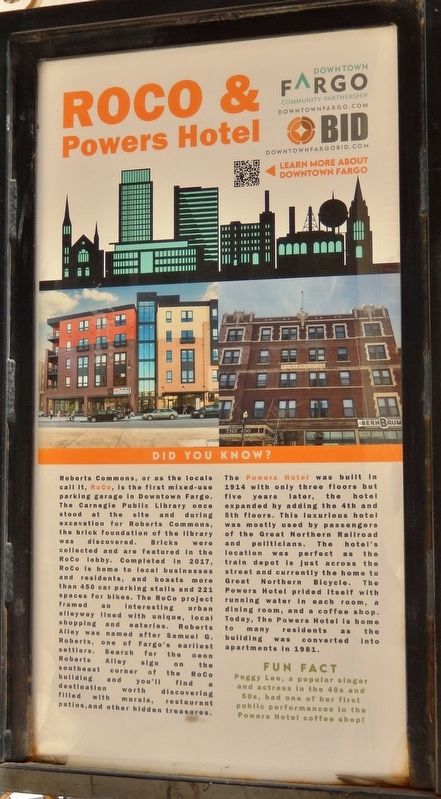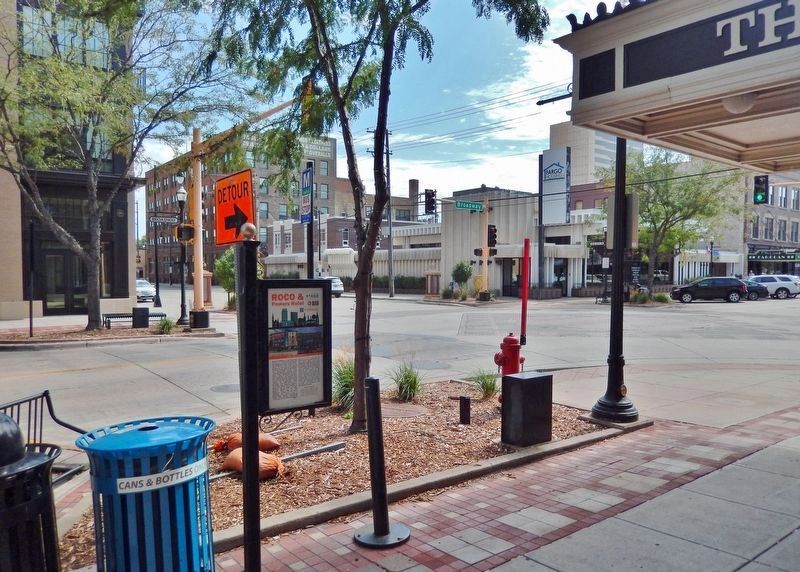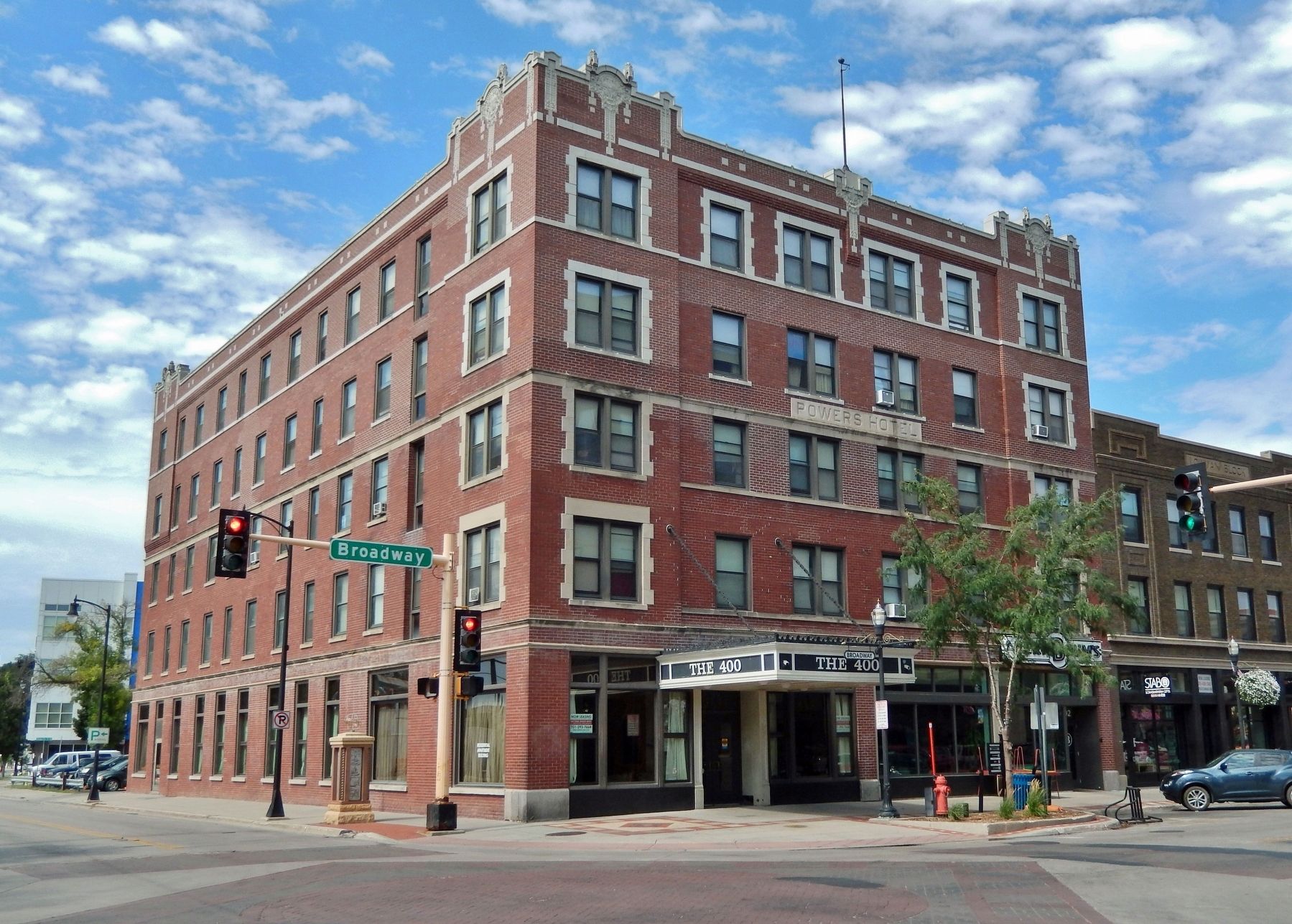Downtown in Fargo in Cass County, North Dakota — The American Midwest (Upper Plains)
ROCO & Powers Hotel
Roberts Commons, or as the locals call it, RoCo, is the first mixed-use parking garage in Downtown Fargo. The Carnegie Public Library once stood at the site and during excavation for Roberts Commons, the brick foundation of the library was discovered. Bricks were collected and are featured in the RoCo lobby. Completed in 2017, RoCo is home to local businesses and residents, and boasts more than 450 car parking stalls and 221 spaces for bikes. The RoCo project framed an interesting urban alleyway lined with unique, local shopping and eateries. Roberts Alley was named after Samuel G. Roberts, one of Fargo's earliest settlers. Search for the neon Roberts Alley sign on the southeast corner of the RoCo building and you'll find a destination worth discovering filled with murals, restaurant patios, and other hidden treasures.
The Powers Hotel was built in 1914 with only three floors but five years later, the hotel expanded by adding the 4th and 5th floors. This luxurious hotel was mostly used by passengers of the Great Northern Railroad and politicians. The hotel's location was perfect as the train depot is just across the street and currently the home to Great Northern Bicycle. The Powers Hotel prided itself with running water in each room, a dining room, and a coffee shop. Today, The Powers Hotel is home to many residents as the building was converted into apartments in 1981.
Fun Fact
Peggy Lee, a popular singer and actress in the 40s and 50s, had one of her first public performances in the Powers Hotel coffee shop!
Erected by Downtown Fargo Community Partnership.
Topics and series. This historical marker is listed in these topic lists: Architecture • Entertainment • Industry & Commerce • Settlements & Settlers. In addition, it is included in the Carnegie Libraries, and the National Register of Historic Places series lists. A significant historical year for this entry is 1914.
Location. 46° 52.815′ N, 96° 47.27′ W. Marker is in Fargo, North Dakota, in Cass County. It is in Downtown. Marker is at the intersection of Broadway North and 4th Avenue North, on the right when traveling south on Broadway North. The marker is located along the sidewalk near the northwest corner of the intersection. It is directly in front of the "400 Building" (formerly the Powers Hotel). Touch for map. Marker is at or near this postal address: 400 Broadway North, Fargo ND 58102, United States of America. Touch for directions.
Other nearby markers. At least 8 other markers are within walking distance of this marker. Eddie and Hildegarde Kraus (a few steps from this marker); The Changing Faces of Entertainment (within shouting distance of this marker); Theaters of Fargo (within shouting distance
of this marker); The Wurlitzer (within shouting distance of this marker); Ford Building & BNSF Railroad (about 300 feet away, measured in a direct line); First Lutheran Church & Cathedral of St. Mary (about 700 feet away); The Ford Building (about 700 feet away); Black Building & Fargo Theatre (about 800 feet away). Touch for a list and map of all markers in Fargo.
Regarding ROCO & Powers Hotel.
Powers Hotel
National Register of Historic Places #83001931.
From the National Register Nomination:
The architectural style of the Powers Hotel can best be described as early Sullivanesque. This is because of its simple massing, absence of classical ornament, simple punched window and door openings, and dynamic organic theme of its parapet ornamentation.
The architects for the lower three floors of the Powers Hotel were the Hancock Brothers of Fargo. The Hancock Brothers are noteworthy not only for their practice in and around Fargo at the turn of the century, but as style setters for the city's architecture. In 1919, William F. Kurke, the architect for the top two floors, provideda consistent, if not emphatic, addition which has proven to be his only work which can be classified as Sullivanesque or Prairiesque. This is apparent in Kurke’s choice for the parapet design, architectural terra cotta.Photographed By Cosmos Mariner, September 4, 20233. Powers Hotel (southeast elevation)From the National Register Nomination: Originally the building was three stories with a brick and stone parapet. This parapet was removed in the 1919 addition of two floors by Fargo architect William F. Kurke. The windows are symmetrically arranged and are composed as one-over-one panes. Windows on the edges of the facade are trimmed with terra cotta toothed into the brick on the top two floors, and stone toothed into the brick on the second and third floors. The south facade is much the same as the east. It is approximately one third longer than the east and is not divided into any vertical bays with the exception of the southeast corner which protrudes approximately 8 inches from the remainder of the wall to add some emphasis and verticality to the corner. Materials are the same as the east facade, as are the distinctive terra cotta ornamental "badges", along with an increase in parapet height. The ornamental pattern is distinctively a Sullivanesque, organic theme, although its shallow relief and occurrence on a few other structures around the midwest mark this ornament as a stock pattern, perhaps from the American Terra Cotta Company, and was probably not an original composition by Kurke. This ornament, nonetheless, may be the best example of Sullivanesque ornament surviving in Fargo.
The builder of the Powers Hotel was Thomas F. Powers, who leased it to his brother Joseph and managed it until 1925, when he moved to the Waldorf Hotel. The Powers family managed the hotel with their sons until 1981, when it was purchased by The 400 Associates Partnership for rehabilitation into elderly housing.
Also see . . .
1. Roberts Commons History. Excerpt:
The Roberts Commons location was the site of Fargo’s first public library, the “Fargo Carnegie Library.” Aided by a $20,000 grant from Andrew Carnegie, the new library opened January 26, 1903.(Submitted on February 3, 2024, by Cosmos Mariner of Cape Canaveral, Florida.)
2. Samuel G. Roberts. Excerpt:
Samuel G. Roberts was born in Brooks, Maine, on March 10, 1843. He was educated in that state and after serving in the Civil War, Roberts came to Minneapolis and studied law. He was admitted to the bar in 1870. Roberts practiced law in Minneapolis until January 1872, at which time he came to Fargo and took up a quarter section of land on which the city now stands. He was instrumental in founding the First National Bank, the Fargo Foundry, and the Republican Newspaper Company. Roberts was very active in public service and served on the territorial council in 1879 and 1883; a member of the territorial commission on emigration in 1877 and 1878; and county superintendent of schools for some time in the 1870s. He also served as municipal judge, was elected to three terms on the city council, and served three terms as city attorney.(Submitted on February 3, 2024, by Cosmos Mariner of Cape Canaveral, Florida.)
3. Powers Hotel (Wikipedia). Excerpt:
The Powers Hotel in Fargo, North Dakota, also known as The 400, was built in 1914 by Thomas F. Powers. It was designed by Hancock Brothers and William F. Kurke. It was listed on the National Register of Historic Places in 1983, and was deemed significant "for its Sullivanesque architectural style as designed by the Hancock Brothers and William F. Kurke", for association with Thomas F. Powers, and "for its role in the commercial development of North Broadway in Fargo, North Dakota."(Submitted on February 3, 2024, by Cosmos Mariner of Cape Canaveral, Florida.)
Credits. This page was last revised on February 3, 2024. It was originally submitted on February 1, 2024, by Cosmos Mariner of Cape Canaveral, Florida. This page has been viewed 110 times since then. Photos: 1, 2, 3. submitted on February 3, 2024, by Cosmos Mariner of Cape Canaveral, Florida.


